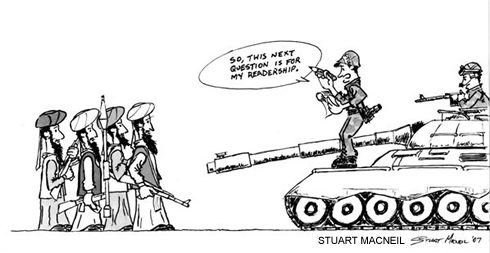Let the Sun Shine In
“You’re right on time,” he says, opening the door to his second-floor apartment in Toronto’s west end. Although his scalp is bare and he’s wearing glasses, he’s nothing like the “bald-headed, squinty-eyed gnome” he described himself as over the phone. Instead, wearing a white dress shirt, navy sweater vest, khakis and brown dress shoes, he looks put together. After helping me remove my jacket, he leads me through the living room and into his office. “I really must show you how wonderful this is,” he says, pointing to the large window over his computer desk. “It’s so nice to be able to work by natural light.”
It’s in front of this window overlooking the visitor parking lot that Michael Kesterton combs through 120 websites, searching for five to six unusual news stories to use in Social Studies, his daily column for The Globe and Mail. Tagged as “a daily miscellany of information,” he has filled the space with stories about things such as a woman sexually aroused by fires, American veterinarians treating pet goldfish, and how not making your bed could eliminate dust mites. Although the stories are mainly inconsequential, readers are hooked. The Facts and Arguments page (which houses Social Studies) is arguably second only to the cover in terms of most-read – not surprising considering the public’s interest in oddball news. At least one unusual news story appears daily on both Yahoo and MSN’s most emailed or most viewed stories lists (and both The Canadian Press and Reuters have ‘weird news’ feeds). But why do people enjoy reading about topics like robots with feelings? “It’s a palate cleanser,” says Facts and Arguments editor Moira Dann. “After reading all kinds of stuff that is generally a downer it makes readers laugh.”
9 Years in the Trenches
 Kesterton’s mother was a real estate agent and his father a professional photographer and trade publication writer. But it was his uncle, Wilf Kesterton, a Carleton University journalism professor, who inspired the young Kesterton’s future career. Although he knew he wanted to be a journalist, Kesterton didn’t take journalism in university; instead, he enrolled in math, physics and psychology courses at the University of Toronto. “I never saw the importance of studying journalism,” says the now 61-year-old. “Really, what you have to learn is how to think and how to evaluate.” Eventually he didn’t see the importance of studying at all. He stopped going to classes and started hanging around The Varsity, U of T’s student newspaper.
Kesterton’s mother was a real estate agent and his father a professional photographer and trade publication writer. But it was his uncle, Wilf Kesterton, a Carleton University journalism professor, who inspired the young Kesterton’s future career. Although he knew he wanted to be a journalist, Kesterton didn’t take journalism in university; instead, he enrolled in math, physics and psychology courses at the University of Toronto. “I never saw the importance of studying journalism,” says the now 61-year-old. “Really, what you have to learn is how to think and how to evaluate.” Eventually he didn’t see the importance of studying at all. He stopped going to classes and started hanging around The Varsity, U of T’s student newspaper.After graduating, he applied to the Toronto Star. Kesterton says the paper turned him down because, while the Varsity was “sex, drugs, and rock ‘n’ roll,” the Star was “sober and industrious.” He didn’t bother applying to the Globe for the same reason. Determined to be a journalist, he responded to an ad looking for retired people to work at the Globe as proofreaders. He thought if he got the job he could make the move to editorial within a year. Things didn’t go as planned. He landed the job but spent seven years as a proofreader and two years in the computer room before becoming a copy editor for Report on Business. Although he worked briefly as a ROB feature writer and Technology section editor, his “dream job” didn’t come until the Globeunderwent a major transformation in 1990.
The “Magnificent Redesign”
When William Thorsell became editor-in-chief of the Globe in 1989, he wanted to change its content and organization. “I was thinking about what matters to the reader. When I’d spend time with friends at dinners and weekends, what they talked about wasn’t in the paper,” says Thorsell. His solution: the Facts and Arguments page. The page would include an essay written by a reader, a column covering different topics such as education, law and science (now replaced with Lives Lived, an obituary) and a column consisting of short, often unusual pieces called Social Studies. It would be on the back page of the A section and complement the cover’s “strong news agenda” with a “strong interest agenda,” says Thorsell.
But there was an obstacle; the back page is high advertorial real estate and was already contracted out to Sporting Life, an athletics store. After a presentation, during which Thorsell presented mock-up pages, Sporting Life executives agreed to give up the back page for ad space on A2 or A3. With that hurdle overcome, Thorsell had to determine who’d write the Social Studies column. Starting at one end of the newsroom, he worked his way to the other, examining every writer. When he got to Kesterton’s cluttered desk, he stopped. “I remembered Michael making a witty comment at a fellow ROB colleague’s goodbye party and thought, ‘This guy must have what it takes,’” says Thorsell. Neither man can recall the comment today.
Starting the job on Victoria Day, 1990, Kesterton completed only four days worth of columns in the following six weeks. “I was finding nothing. I was sure they were going to fire me.” But they didn’t and he found his groove. He’d go to Lichtman’s, a bookstore across the street from the Globe offices, and buy twelve different newspapers such as The Boston Globe, The Miami Herald, and The Philadelphia Inquirer. He’d then bring them back to the Globe’s library and hunt through them, searching for material.

One day, shortly after the redesign launched on June 12, 1990, Thorsell saw numerous Globe front pages staring at him on the subway. “It was exciting because it meant people were reading the back page,” he says. And it wasn’t an isolated incident. Six weeks after the redesign, when Globe managers were on an executive retreat, their waitress asked to meet the guy who wrote Social Studies. Focus groups also proved that people — lots of them — were reading the Facts and Arguments page. “We’d suddenly hit gold,” says Kesterton.
Gold Rush
Although online rankings show unusual news is gaining popularity, Kesterton insists his column is not strictly weird stories. “It’s everyday news that has a bit of a twist,” he says. “It intrigues you.” Stories that make it into Kesterton’s column have to interest him and be significant. When asked what significance a story about a woman aroused by fires could have, he replies, “I thought, ‘How strange…’ It is interesting because it makes you think about what stimulates people.”
Scalping

Kesterton says he’s a scalper: not doing his own interviews and pulling from other sources. He tries to make this clear to readers by diligently citing all sources. But his dry sense of humour still shines through in his paraphrasing and subtitles. In a story titled “Birds do it, bees do it,” Kesterton highlights research suggesting that an evening of lovemaking could rid you of headaches. Sometimes the simplest stories, though, are the most humorous. He once printed just the caption of a photograph from a board of directors meeting report. “I noticed almost everyone’s name was Mr. Smith, Mr. Jones, Mr. This…and Wendy,” he recalls. “It said something about the way they look at women.”
Kesterton’s stories may make you think, but they are also easily forgotten. Even he admits that often he can’t remember stories he wrote the previous week. He does, however, have a memory for statistics. Did you know if there are 23 people in a room, the chances are 50/50 that two of them share a birthday?
Striptease
“I think anybody who reads my column will get the impression that the guy who writes it is good natured, and maybe quick-witted and on top of things,” says Kesterton, “while I’m kind of a morose worrywart and I don’t know anything until I’ve just seen it.” Though his friends and colleagues agree he’s shy, they disagree with him about his sense of humour and intelligence. “He has an incredible memory,” says Dann. “If you want to know who Toto’s trainer was on The Wizard of Oz, ask Michael.” All of his friends cite his deadpan sense of humour as a Kesterton characteristic, though no one can recall a specific anecdote.

Perhaps his friends were worried about telling me too much since Kesterton is leery about revealing himself outside his column. “Don’t show them the real you — people might yawn,” he says. “It’s like striptease. I mean, anyone can do it in theory. But unless you enjoy being looked at and can take the yawns, well, don’t.” The naked truth is that to escape work Kesterton plays squash at the gym. His squash buddy, Katherine Dalziel, says most of the women at the gym know his name. Kesterton’s also just finished writing the last chapter of a novel. It’s set in 1925 Africa, though he hasn’t been within “a million miles of Africa.”
“Hooray for Me!”
His column isn’t life changing and the details of its stories aren’t memorable. But he is content spending his days searching websites for “news with a twist” and writing squibs that offer readers a little humour in their often serious and stressful lives. He’s content working under his window.
Thought du jour
“There are hundreds of reporters who can do a better job at [news stories] than I ever could… The light-hearted hack work that I am doing isn’t hugely important and will never win journalism awards, but I’m better at it than anyone I know and readers often love the columns and tell me so. There are worse ways to earn a living.” – Michael Kesterton
About the author
Dayna Dayus was the Visual Editor for the Spring 2007 issue of the Ryerson Review of Journalism.

